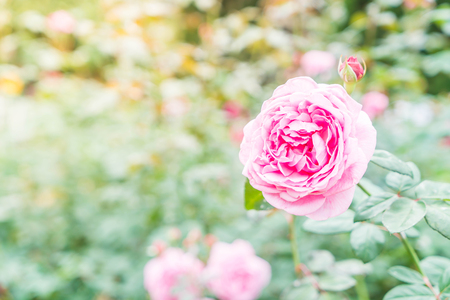Introduction to the Cottage Garden Aesthetic
There’s a certain magic woven into the tapestry of an English cottage garden, a style that has charmed generations with its informal elegance and riotous abundance. Originating centuries ago as practical plots surrounding humble country homes, these gardens once combined fruit, vegetables, herbs, and flowers in a delightful jumble. Over time, they evolved into an iconic symbol of rural England, celebrated for their billowing borders of old-fashioned blooms like roses, delphiniums, foxgloves, and lavender. The secret to their lasting beauty isn’t simply a matter of luck or rain; it lies in the careful hand of the gardener, whose seasonal rituals—deadheading among them—ensure continuous colour and health throughout the year. As anyone who has wandered down a winding village lane in midsummer knows, the true heart of the cottage garden is found in its ability to balance wildness with attentive care, creating a living legacy that connects us to both history and home.
2. Understanding Deadheading: What and Why
Deadheading is a term cherished by English gardeners, especially those tending to classic cottage gardens brimming with vibrant blooms. In essence, deadheading means removing spent or faded flowers from your plants. This simple yet essential task holds a special place in the heart of an English gardener’s year, playing a pivotal role in both the health and beauty of the garden.
By snipping off old blossoms, you’re encouraging the plant to divert its energy from seed production back into generating new flowers. For many iconic English blooms—think roses, delphiniums, and sweet peas—this practice not only prolongs their display but also keeps borders looking neat and lively. It’s a time-honoured tradition that has graced British gardens for generations, ensuring that beds remain as colourful in late summer as they were at the height of June.
The importance of deadheading goes beyond mere aesthetics. Plants left to set seed will often slow down or stop flowering altogether, leaving your cottage borders looking lacklustre before their time. By regularly deadheading throughout the growing season, you’ll be rewarded with repeat flushes of blossoms and a garden that feels ever-youthful.
| Benefit | Description |
|---|---|
| Prolonged Flowering | Encourages plants to produce more blooms throughout the season |
| Tidier Appearance | Keeps borders neat by removing faded petals and seed heads |
| Healthier Plants | Prevents disease by removing decaying material promptly |
| Controlled Self-Seeding | Reduces unwanted spreading of certain vigorous varieties |
Traditionally, English gardeners consider deadheading a gentle ritual—a moment for reflection while strolling through flower-laden paths. Whether using secateurs or simply pinching off heads between finger and thumb, it’s an act rooted in both practicality and affection for one’s plot. In truth, mastering this art ensures that your cottage garden remains a tapestry of colour from spring right through to autumn’s last hurrah.

3. Classic Cottage Blooms and Their Deadheading Needs
If you’ve ever strolled through an English cottage garden, you’ll know it’s a tapestry of colour and texture, where each bloom earns its place with charm and vigour. Among these classics, roses, delphiniums, and hardy geraniums are the true stalwarts—each requiring a slightly different approach when it comes to deadheading.
Roses: The Quintessential Cottage Favourite
Nothing says “English garden” quite like a flush of fragrant roses tumbling over an old stone wall. For repeat-flowering varieties, such as hybrid teas or floribundas, regular deadheading is key to encouraging fresh blooms right into autumn. Wait until the petals begin to drop and the flower looks spent; then snip just above a strong, outward-facing leaf node. For old-fashioned or single-flush roses, you may wish to leave the hips for autumn interest and wildlife value.
Delphiniums: Tall Spires of Summer
Delphiniums add stately drama to any border but can quickly look bedraggled once their main flush fades. As soon as the flowers have faded on their tall spikes, cut the stem down to the base. With a bit of luck and some British rain, you may be rewarded with a second, albeit smaller, flush later in the season. Always use sharp secateurs to avoid damaging these hollow stems.
Hardy Geraniums: The Reliable Fillers
Unlike their bedding cousins, hardy geraniums are invaluable for weaving through borders. They often respond brilliantly to what gardeners call “the Chelsea chop” or a midsummer shear. Once flowering begins to wane and seed pods form, trim back all spent growth—don’t be shy! This encourages a neat mound of fresh foliage and sometimes another sprinkling of flowers before summer’s end.
Traditional Wisdom for Timeless Results
The secret handed down from seasoned English gardeners is simple: observe your plants closely and deadhead with intention. Each classic cottage flower has its own rhythm—by tending to them thoughtfully, you’ll extend their beauty and keep your garden looking its best throughout the long British summer.
4. Tools and Techniques: Doing the Job Right
When it comes to deadheading those cherished cottage garden classics, having the right tools makes all the difference. Over the years, I’ve tried everything from high-end gadgets to simply using my own two hands, and let me tell you—sometimes the oldest methods are still the best. Below is a quick guide to recommended tools, each with its own purpose and place in the English gardener’s shed.
| Tool | Best For | Top Tip |
|---|---|---|
| Secateurs (Pruners) | Woody stems like roses and peonies | Keep them sharp and clean to avoid disease spread |
| Snips or Scissors | Delicate flowers such as sweet peas and cosmos | Ideal for precision work around tight clusters |
| Thumb & Finger Pinch | Pansies, violas, geraniums, and smaller blooms | Pinch just above a leaf node for bushier regrowth |
| Long-Handled Shears | Larger drifts of annuals or border edges | Great for quick tidy-ups after main flushes |
The Gentle Approach: Why Soft Hands Matter
A wise old gardener once told me that plants respond to a gentle touch just as people do. For those tender blooms—think campanulas or delphiniums—a careful pinch between thumb and forefinger can be less stressful than even the sharpest blade. This method lets you feel for spent blooms without risking damage to young buds forming below.
Timing Your Deadheading Rounds
If you want your borders to look their best throughout the season, make deadheading a weekly ritual. Early morning or late afternoon are ideal times—cooler temperatures reduce plant stress, and you’re more likely to spot which blooms are truly spent under soft daylight. For larger swathes of flowers, a pair of trusty secateurs will save your hands from fatigue during longer sessions.
Old-School Tips Passed Down the Allotment Path
– Always carry a small bucket or trug for collecting spent heads; it keeps your beds tidy and saves a second trip.
– Wipe blades with an alcohol-soaked cloth between different plant varieties—prevents spreading issues like blackspot.
– For self-seeders such as foxgloves and poppies, let some blooms go to seed if you fancy a surprise next spring—nature’s way of keeping the cottage charm alive.
– And never underestimate the humble thumb: sometimes, all it takes is a simple twist and pull to keep your English favourites thriving from June to Michaelmas.
5. Troubleshooting Common Deadheading Dilemmas
Spotting the Difference: Spent Blooms vs. Seeding Heads
One of the most frequent quandaries faced by English cottage gardeners is distinguishing between a bloom that’s truly spent and one that’s setting seed. The key is in close observation: spent blooms tend to look faded, wilted or papery, while seed heads are often plumper, sometimes with visible swelling beneath the petals or developing fuzziness. With iconic cottage garden flowers like delphiniums, foxgloves, and roses, spent blooms will have lost their vibrant colour and begun to droop, whereas seed heads might appear more structured or even ornamental in their own right. Take time to learn each plant’s habits—some, like poppies or nigella, offer attractive seed pods that you may wish to leave for autumn interest or wildlife benefit.
Common Mistakes and Practical Solutions
Deadheading Too Early or Too Late
One pitfall is deadheading too soon, which can rob pollinators of nectar or prevent the plant from completing its cycle. Wait until petals have fully faded and begun to drop before snipping. On the other hand, leaving it too late can result in seeds being set, which diverts energy away from further flowering. Regular strolls through your garden with secateurs in hand will help you catch blooms at just the right stage.
Incorrect Cutting Technique
A common error is simply snapping off petals or cutting too high on the stem. Always use clean, sharp secateurs and cut back to the first healthy leaf set below the flower head. This encourages strong new growth and maintains the neat appearance beloved in traditional English borders.
Damaging New Buds
Especially with clustered bloomers like geraniums or cosmos, it’s easy to accidentally remove buds along with spent flowers. Gently part foliage to check for emerging buds before making your cut—this careful approach ensures you won’t miss out on the next flush of classic cottage colour.
Embracing Imperfection
Finally, remember that some level of imperfection is part of cottage garden charm. If a few seed heads are missed, they may provide food for birds or self-sow for next year’s display. The hallmark of an English cottage garden is its relaxed abundance—so don’t fret over every detail; enjoy the process and let nature lend a helping hand where she will.
6. Encouraging Wildlife through Judicious Deadheading
While the traditional English cottage garden is famed for its abundant blooms and well-tended borders, there’s an art to striking the right balance between a tidy appearance and supporting local wildlife. Deadheading, when done thoughtfully, can do wonders not only for your flowers but also for the birds and pollinators that call your garden home.
Knowing When to Stop Deadheading
It’s tempting, especially at summer’s height, to keep snipping away faded flowers in pursuit of fresh colour. However, as autumn approaches, it’s wise to resist the urge with certain plants. Iconic English blooms like rudbeckias, echinaceas, sunflowers, and teasels produce seed heads that are a valuable food source for finches, sparrows, and goldfinches during the leaner months. Instead of removing every spent flower, allow some to mature and dry on the stem. This way, you create a natural larder for garden visitors while still keeping most of your beds neat.
Supporting Pollinators with Selective Deadheading
Pollinators such as bees and butterflies also benefit from considered deadheading. By leaving late-season flowers of sedum or Michaelmas daisies uncut, you provide nectar into the autumn. A good rule of thumb is to deadhead robustly during early and mid-summer to extend flowering but begin to leave more seed heads as August turns to September.
Aesthetics Meets Wildlife Haven
No one wants their beloved cottage garden looking wild and unruly—so how do you find the middle ground? Try grouping your ‘wildlife corners’ in less prominent spots: perhaps at the back of borders or near hedgerows. Here you can let honesty pods rattle in the breeze or foxglove spikes stand tall through winter frosts without sacrificing curb appeal. This approach means you enjoy a garden brimming with classic charm while giving nature a helping hand.
In essence, judicious deadheading isn’t just about human enjoyment—it’s about nurturing a living landscape. A true cottage garden isn’t just a feast for the eyes; it’s a sanctuary for all creatures great and small. With a little forethought and tradition on your side, you’ll have both glorious blooms and a bustling wildlife haven right outside your door.


